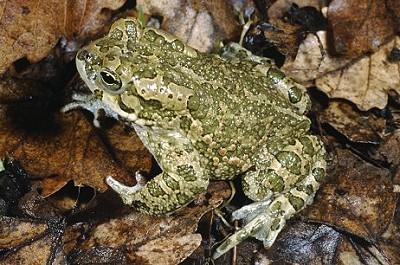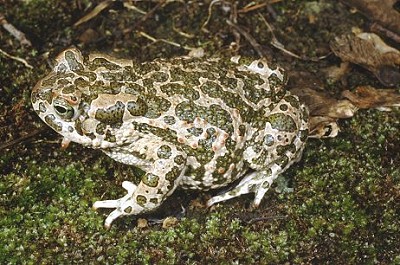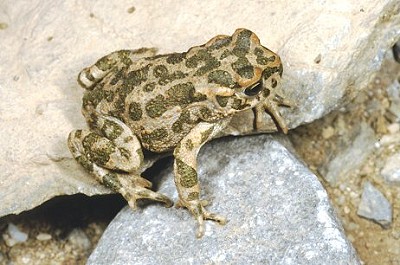| Bufo viridis (European Green Toad): A report by Stefan Keeping
The Bufo viridis are kept in a planted terrarium without water container the whole year.
The toads get their water from the wet bottom after the plants are watered.
We use potting compost (without fertilizer!) as substrate.
The windows of the terrarium room always stay open. As a result room temperature varies somewhat depending on temperatures outside; during summer warmer and during winter cooler.
Breeding
The toads were given a dormancy. Thereafter they had the possibility to walk free on an area of 6x4 m for a several days and then were moved to a water filled terrarium with permanent rain system. There they laid their eggs. As a rain terrarium I use a normal terrarium with a size of 80x40x40 cm (LxWxH) for 5 cm big species. At the beginning I start with a water level of 5 cm and later increase to a water level of approx. 20 cm. Two brick stones serve as an island. I also place a several plastic scindapsus plants in the water. As a rain system I include an Eheim pump in the water. The suction side is covered with foam to prevent suction of eggs. I connect a tube to the side where the water comes out. At the terrarium ceiling is a tube with holes as used for external filters for fish tanks. I connect the tube coming from the pump to the tube with the holes. You also may use two tubes with holes connected to a circle and then connect this construction to the tube of the pump. If you turn on the pump now, it is raining from the ceiling.
Additionally to this permanent rain I slowly fill in somewhat cooler water (approx. 20°C). Then water level rises to approx. 20 cm and the toads are barely able to sit. Thereafter you may warm up the water with a fish tank heater to 26°C again. This supports the effect of stimulating conditions during and after a real rain outside. You may repeat this procedure a several times. The toads can be left in this setup without feeding for a week but you should observe them carefully to be sure they are fine. In case the toads do not lay eggs within a week they should be moved out of the rain terrarium. In many frog species it is not uncommon that males are amplexing without any breeding success. The females need any further stimulation. I still try to find out what kind of stimulation is missing. Then you need to try a several things, for example let them walk around, increase day time, 1/3 water change by 20°C cool water and parallel increase of water level until the toads only have few places to sit. You should place a lot of plastic plants or scindapsus plants in the water at which the females may lay their eggs. I feed the tadpoles with Tetramin, Tabimin and Spirulina. Obviously most tadpoles are herbivore. Therefore they have a very long intestinal. You should give the tadpoles enough place to develop well. This ensures that the tadpoles grow larger and the young toadlets will be larger when approaching land, too. This makes feeding much easier. I also believe that the amount of oxygen in the water is very important. This means that water temperature also is important, as cold water contains more oxygen than warm water. So, depending on water temperature you may keep different numbers of tadpoles. I keep the tadpoles at a temperature of approx. 23-25°C. Water quality also is important. Especially keep an eye on nitrat. I exchange 2/3 water with some days old tap water daily. You should try if usage of fresh tap water is possible. Some tadpoles blow up, others do not. With toad tadpoles I did not have this problem. I estimate that 1 liter water per tadpole is sufficient. But you may experiment with a several fish tanks. I use tap water (GH 16, KH 8 annd PH 8) but also used other water without noticing any difference. |
|||


